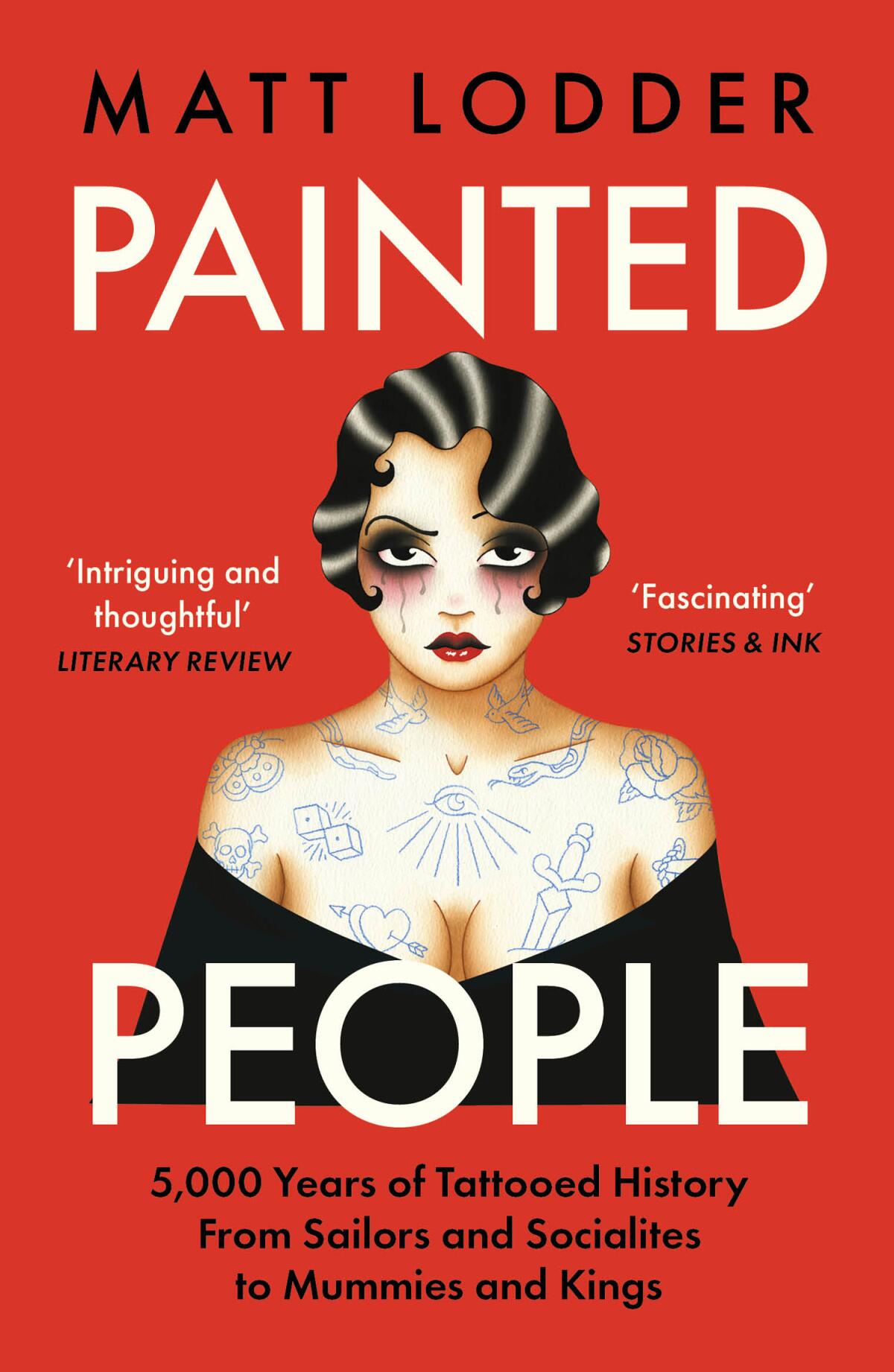What Dennis Rodman, Kate Moss and a 5,000-year-old Alpine iceman have in common

- Share via
Book Review
Painted People: 5,000 Years of Tattooed History from Sailors and Socialites to Mummies and Kings
By Matt Lodder
William Collins: 352 pages, $21.99
If you buy books linked on our site, The Times may earn a commission from Bookshop.org, whose fees support independent bookstores.
One of the most stubborn misconceptions about tattooing is that it was born in Polynesia and imported to the West by Captain Cook in 1768, then trickled down to the masses over the next century, settling into military and criminal subcultures until its late-20th century resurrection in the middle class. It’s not only false but also eclipses a much broader and more complex global heritage.
Matt Lodder’s “Painted People: 5,000 Years of Tattooed History from Sailors and Socialites to Mummies and Kings” brings that truth to life in 21 riveting stories. Lodder, a scholar of tattoo history, doesn’t argue for the artistry or legitimacy of tattoos but rather shows — in lively and accessible language — how they serve as points of entry into so many aspects of culture: history and anthropology, sports and fashion, war and medicine. Lodder examines their material and spiritual origins as well as their cultural impact.
“I want to show you that tattooing connects us across historical time and geographical space, revealing details about human experience in the process,” he writes.
‘The Bloodied Nightgown’ is a monument to Joan Acocella’s savage wit and unsentimental generosity
An eclectic collection of essays on subjects including Dracula, dirty words and Elena Ferrante is a tribute to its writer, who died last month at age 78.
Though it’s organized by period, from the ancient world to the new millennium, “Painted People” is not a chronology. Tattoo history is not linear, and its timelines are always shifting.
The book opens with the story of Ötzi, one of the oldest known tattooed humans, whose more-than-5,000-year-old body was found preserved in the Italian alps in 1991. It also details the recent discovery of 3,000- to 5,000-year-old tattoo tools in Tennessee, which bumped the origins of North American tattooing back a full millennium.
Both cases present tantalizing mysteries: Because most of Ötzi’s dozens of abstract tattoos appear in places where only a right-handed person could reach, it’s possible that he tattooed himself. And when chiseled turkey bones were unearthed on Tennessee land once inhabited by the Cherokee, Chickasaw, Shawnee and Yuchi peoples, archaeologists weren’t sure if they were for tattooing, medicinal uses or leatherworking. In what Lodder calls “an act of gonzo archaeology,” the scientists carved their own needles from turkey bones, dipped them in ink, tattooed themselves and concluded, based on microscopic examination of their “wear patterns,” that the ancient needles only could have been used to tattoo.

“Painted People” is such a robust miscellany that it’s possible to dip in anywhere and find something astonishing: the artist Lucian Freud tattooing swallows on supermodel Kate Moss; a Tang-era Chinese text describing a peacock gallbladder used as tattoo ink; North Korean prisoners of war forcibly marked with anti-communist slogans; Christian and Islamic pilgrimage tattoos thriving in 16th century Jerusalem; and, in a spasm of Cold War anxiety, Indiana schoolchildren tattooed with their blood types under their left armpit, just as Nazi soldiers had been during World War II. The location, Lodder explains, was “least likely to be seriously burned or slashed by flying debris.”
Not every story involves blood and ink: In 1929, following a tattoo craze among young people in the U.S. and Britain, the designer Elsa Schiaparelli created custom swimsuits featuring patterns from an array of classic tattoos copied, she said, “from the manly chests of French mariners.” Knitted into “sunburn”-colored fabric, the garments made beachgoers appear nearly naked but for the mermaids and pierced hearts hugging their torsos. “The hypermasculine associations of tattooing” suited the moment, Lodder writes, “as androgyny and boyishness had become de rigueur.”
Like many folk art and Indigenous practices, says Lodder, tattooing tends to be fundamentally “conservative, preserving imagery and iconography over centuries, if not millennia … often communicating quickly and bluntly rather base and universal emotions about fear, hope, and familial ties.” Even custom tattooing in the West, he notes, “almost inevitably” signifies group rather than individual identity.
Calvin Trillin’s new collection of stories, ‘The Lede: Dispatches From a Life in the Press,’ reminds us not just of his brilliant plying of the trade but also of what the trade once was.
The 1990s NBA star Dennis Rodman, by contrast, used his ink — along with his piercings, dresses and technicolor hair — to mark himself as “a true individual in a deeply conservative culture.” Like soldiers and convicts whose individual identities are disguised by uniforms, athletes have few options for creative self-expression. But basketball players’ exposed skin provided an alluring public canvas that Rodman filled with tattoos, inspiring generations of athletes to do the same. His passion for the art form also helped integrate the white-dominated tattoo world, where for too long Black customers had been told their skin was too dark to carry legible designs.
When Rodman sued a company selling T-shirts mimicking his tattooed torso, he prefigured a 21st century tattoo problem: fair use. The appearance of custom tattoo designs in films, fashion and video games has been legally contested. But, Lodder asks, if a finished tattoo itself infringes on a copyright, how can a “cease and desist” order be enforced? Likewise, what are the legal implications of a hacked numeric decryption code tattooed on a man’s body and then photographed and shared online? Though tattooing has changed little technically since ancient times — apart from the 19th century invention of the tattoo machine — modern technology is investing it with thorny new implications.
The tattooist Ed Hardy once said that tattoos are like “little vents” into the wearer’s psyche. Lodder presents them as portals to whole peoples. Some of their practices were canceled by colonialism; others, preserved in ice as Ötzi was, are dissolving with the melting permafrost, taking the visual keys to ancient cosmologies with them. Deeply researched and elegantly written, “Painted People” is a moving, entertaining tribute to the people — and peoples — behind this underexamined medium.
Margot Mifflin is a professor at the City University of New York and the author of “The Blue Tattoo: The Life of Olive Oatman.”
More to Read
A cure for the common opinion
Get thought-provoking perspectives with our weekly newsletter.
You may occasionally receive promotional content from the Los Angeles Times.











